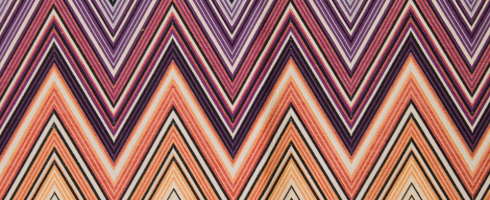No one would argue with the fact that recognition of monograms and patterns stimulate consumer demand. Remember bag Louis Vuitton. Even if you do not mod, bags and you do not need, you always know what they look like and what it means monogram LV.
Anyway, for all such recognizable patterns and patterns on the idea, and it is not always motivated by commercial purposes. I understood almost all come to mind patterns of brands and realized that all of them are divided into two groups: the strict geometry and floral motifs. Let's start with geometry.

Missoni zigzags and Kaleidoscope
Ottavio Missoni and his wife Rosita first produced knitwear with a simple strip. Then the strip into a zigzag - this idea belonged to Rosita, who was inspired by African patterns and the spirit of pop art. From the 70s to the present day began bright zigzag pattern recognizable fashion house Missoni.
Cage and monogram Louis Vuitton
The fashion house Louis Vuitton rich patterns, and each of them meets the trends of his time. The first and perhaps most famous pattern in the cell (Damier Canvas) invented in 1888 Louis Vuitton himself with his son George. In 1896 was released a new pattern - the famous golden monogram LV, whose purpose was to protect goods from counterfeiting. These two key pattern and to this day are the key, but over the years in the fashion house when there is something new.
In 2003, Takashi Murakami is compatible with Marc Jacobs released a collection of bags with classic monogram pattern, but in 33 colors.
Then Takashi LV monogram diluted cherry blossom with a smiling character inside the flower - things from his series of sold limited edition. Also in the collection appeared cherry patterns and classical cell, but white-gray, and the last was the pattern of colored peas Yayoi Kusama Japanese artist.
Vest Chanel and Gaultier
In the history of the event is a simple vest and cunning idea. Striped blue and white robes appeared as part of a form of English sailors. In the mid-18th century, ships were still sailing, so blue and white sailor on the mast was well aware of all the crew, but the enemy from afar saw nothing - vest merged with the blue sky and white sail. Later, during the revolution vest loved women, and their first noticed Coco Chanel - in fact, she became a legislator striped fashion. Now for the main strip acts Jean-Paul Gaultier, who always walked in striped things, and when he was a designer, has produced many white and blue items.
Cell Burberry
The history of this pattern - simple and sweet. Thomas Burberry in 1879 began producing gabardine - in those years, a new type of waterproof fabric. In the early 20th century, his company began producing Burberry gabardine coats for the army lined the now famous cage - she had to remind the soldiers home plaid. Since then, this "pledny" pattern is ubiquitous in all lines of fashion house Burberry.
Strips of Paul Smith
British designer Paul Smith was the first who began to feel free to use colored and striped patterns in a man's suit. So bright strip of elements into a corporate "barcode" of the fashion house Paul Smith.
Geometry Verner Panton
Danish designer Verner Panton was the founder of many concepts and design on its head turned in those years very very strict Scandinavian design, saying that the furniture need not be legs, handles, and make it possible from anything.
Danish designer Verner Panton was the founder of many concepts and design on its head turned in those years very very strict Scandinavian design, saying that the furniture need not be legs, handles, and make it possible from anything.
In addition to furniture, he created some of his famous sealed patterns produced in several colors. Now symmetrical circles and squares are used everywhere and all - as a well-known manufacturers of furniture and accessories, as well as Chinese factories producing plastic bags.